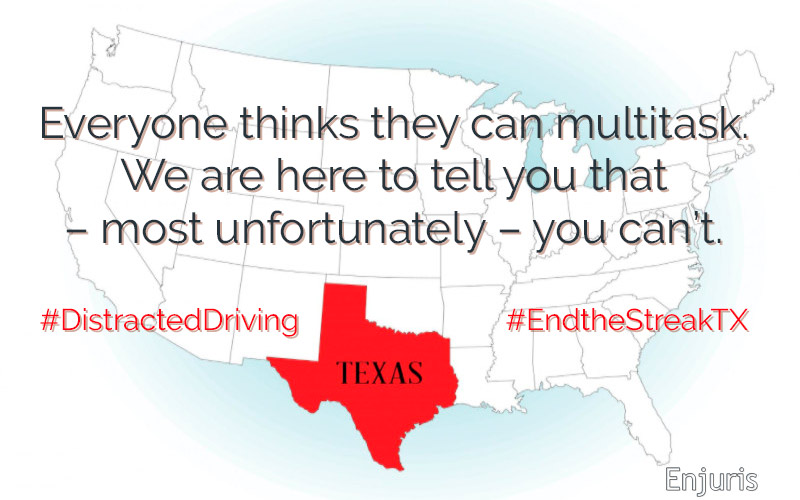Hablamos español.
Texting while driving? And other distractions: It can wait.
At least one person has been killed on a Texas road every day for the past 16 years.
You read that right. There's even a hashtag campaign for it now: #EndtheStreakTX.
The Texas Department of Transportation (DOT) has been keeping track since November 7, 2000, and when they reached that grim milestone, they knew that something had to be done.
They created the campaign to educate drivers about these preventable deaths, to share personal stories about loved ones lost in crashes, and to promote the hashtag so more people are aware. They also offer some simple tips: Buckle up. Don't drink and drive. Drive the speed limit. Pay attention.
Paying attention is our focus in this article. Distracted driving is the number-one cause of teen driving death in the United States. Everyone thinks they're able to multitask, and we are here to tell you that – most unfortunately – you are not.
Distracted driving statistics
If you answer a text while driving, it takes approximately 4.6 seconds. Let's say you're driving at a speed of 55 miles per hour; that's the equivalent of driving across a football field. While blindfolded.
Studies completed in Texas discovered that almost 10% of drivers on the road are on their phone right now. Furthermore, one in four crashes involves a distracted driver.
Christine Yager, a transportation researcher, wanted to find out if voice-to-text software was actually safer than those who tried to send a quick text while stopped at a red light. This was what she found for Texas drivers:
- While drivers think they're being safer when using voice-to-text methods, they offer no safety advantages over manual texting.
- Driver response times were significantly delayed no matter which texting method was used.
- In each case, drivers took about twice as long to react as they did when they were not texting. (So imagine the pedestrians and road hazards in front of their car!)
- The amount of time drivers spent looking at the road was significantly less when they were texting, no matter which method of texting they used.
- Drivers felt less safe with manual texting and safer with voice-to-text, even though their performance was approximately the same with both.
Separately, the Insurance Institute for Highway Safety has linked talking on a cellphone while driving to a fourfold increase in the chance of a crash.
Measures taken in Texas against distracted driving
Texas has created the Talk. Text. Crash. campaign to raise awareness of distracted driving and the danger it poses to both teenagers and adults. Surprisingly, the most affected age groups are teens and adults over the age of 45. This campaign has joined forces with AT&T's It Can Wait crusade, which aims to get people to pull over to the side of the road or just wait until they're done driving to answer a call or text message.
Distracted driving can take include any of the following:
- Posting to social media
- Grooming (brushing hair, putting on makeup, etc.)
- Eating
- Checking email
- Reading
- Using a navigation system
- Watching a video
- Adjusting music players
Basically, anything that takes your eyes off the road and your hands off the wheel is distracted driving. Taking a selfie? Changing the radio station? Have to check your work email? Sitting at a red light and scrolling through Twitter? Wolfing down a donut before you get to work?
Even changing your shoes or falling asleep! (See how one woman was rear ended twice with these distracted driving excuses.)
Phones are definitely the biggest culprit and have been the aim of most laws. While there is not a statewide law against texting while driving, there are several local bans (such as a ban on cell phone use and texting for bus drivers; a ban on cell phone use and texting for novice drivers under the age of 18; and a ban on cell phone use in school zones). There are also several cities where texting where driving is outright banned. Fines for these offenses range between $200 and $500.
What if I get hit by a distracted driver?
Getting into a car accident with a distracted driver means speaking with an attorney who is well versed in motor vehicle cases, but these cases have an interesting twist. Many litigants have also been naming cell phone makers as defendants when they go to trial because they claim they are not doing enough to prevent users from using their phones while driving.
Tweet this
For instance, on Christmas Eve, 2014, a driver in Texas was using FaceTime while driving. This is video software used for face-to-face conversations. He crashed into the back of another vehicle, which killed the five-year-old girl in the backseat. In their lawsuit, the parents' pointed out the most damning piece of evidence: the fact that Apple had created and patented a lockout system for phones while driving, but hadn't put it into public use. This app would have meant that FaceTime would not be usable while driving.
Apple's response was that if they were held responsible, then every third party was responsible for what happened to drivers in accidents: fast food restaurants, beauty suppliers, music producers, bookstores and whatever else could potentially distract you. The line had to be drawn somewhere, and they chose to draw it themselves.
While the argument has been made, it has not yet been accepted at our time of publishing this article.
Even if the argument isn't accepted, there are other arguments to make. Using a cell phone while driving indicates that the driver was potentially breaking traffic laws; many states have enacted them over previous years. Reviewing cell phone records can pinpoint when and where the driver was using a phone, and when that is determined, then fault can be apportioned between the drivers in the accident (depending on the fault system in the state itself).
Texas, being a comparative fault state, would apportion the percentage of fault between the drivers based on who did what wrong.
Driving while on a cell phone would certainly not weigh the scale in that driver's favor. If you were hit by a texting driver, there's a very good chance that you would win your case – depending on the city in which the case happened, that driver could have broken the law. Even if you were in a city that didn't have an express ban against texting while driving, the atmosphere in Texas is hostile toward those drivers.
Either way, it makes most sense to speak to Texas attorneys who have dealt with these matters before. Try an Enjuris law firm in Texas who is well versed in both motor vehicle law and traffic statutes.
In our blog: Most Dangerous Houston Roads and Intersections.
See our guide Choosing a personal injury attorney.


